#ammonia fermentaion
Text
Alrighty so this is the post on lichen dyes!
this particular bath of lichen dyes was originally started over a year ago scraping a tentatively-ID'd lecanora and/or ochrolechia genus lichen off of a fallen branch (remember, don't gather lichen when it's still growing! it's very slow growing and easy to overharvest)
to start off, this particular type of dye is made through the ammonia-fermentation method, also known as ammonia maceration. No actual bacterial fermentation occurs though. Rather, the compound orcinol (and precursor compound to orcinols) react with ammonia (N2) and oxygen to form the compound orcein (also called orchil/archil) which is what makes the final dye!
this process takes anywhere from 3 weeks to 16+ weeks depending on the lichen species, its constituent acids, the temperature, and the frequency of aeration.
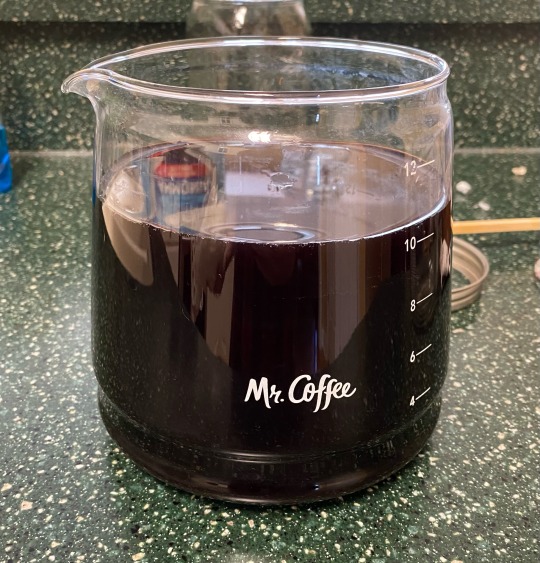
This batch was set aside for several months and neglected a good bit, but it still works. I strained out the crumbled lichens (which i set aside for later) and diluted it 1:4 as instructed by a very good book called Lichen Dyes: The New Source Book by Karen Diadick Casselman. This book is basically omnipresent everywhere you see lichen dyes mentioned, especially the orcein-based dyes. I also used several websites/videos/papers and such that i've hunted down over various internet crawls.
I use an old coffee pot for this as it's both a non-reactive material (glass) and is built to withstand heat. Ironically i also scraped the lichens off the branch using a tool i made out of a metal band from the broken handle of this same coffee pot!

I decided to dye some eri silk cakes that i fluffed up and scoured. these have been very good at absorbing dye in the past so i would hopefully get a good result from them. As lichens are a substantive dye i don't have to put a mordant on them, but i did soak them in an alum solution just before adding them to the dye bath to hopefully maximize dye uptake as well as improve fastness as lichen dyes are also fugitive and can fade in sunlight.
Substantive dyes contain mordants already embedded in them; fugitive dyes are a bit fuzzy to me but my understanding is they end up trapped in the fiber instead of actually bonding to the fiber in a stronger way. Mordants are used to help the dye "bite" onto the fiber better, improving both fastness (the ability of a due to resist fading from sunlight/washing/time) and the brightness of a color. Alum is useful in that it typically doesn't affect the end color of a dye more than simply making it slightly more strong!
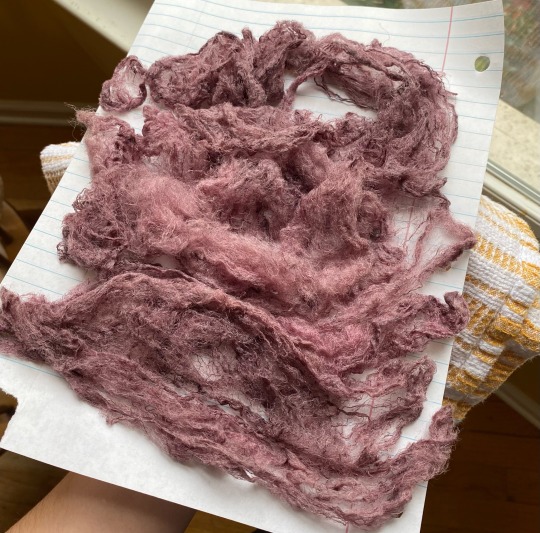
it was pretty successful i'd say! i warmed up the dyebath, added the silk, let it simmer for a few hours, let it cool down overnight, and then warmed it back up the next day for a few hours; then, when it cooled, i took it out, let it dry, then rinsed it, and let it dry a second time. At that point, it was ready for spinning!
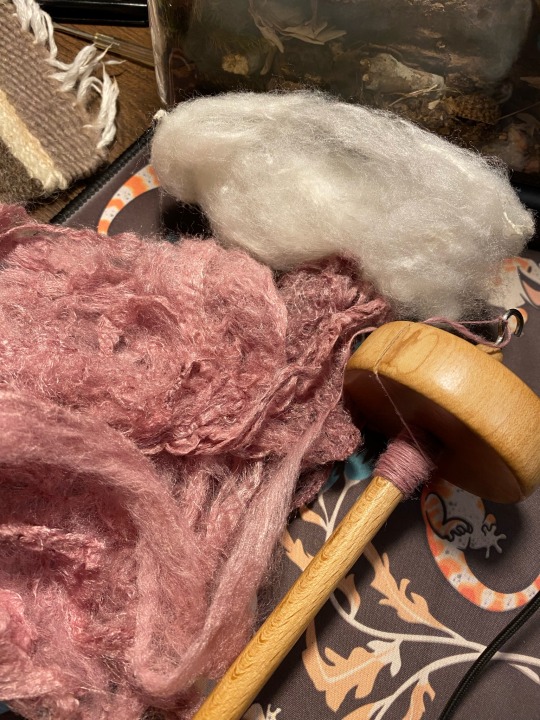
It was a lovely pink color that's not fully captured by the camera like most dyes, and eri silk is lovely because you can spin the clouds directly and easily without carding and make lovely relatively threadlike yarn

this was the first skein i got! i love how shiny the silk is. Some dyes can get really purple or even magenta-like!
next, i had the leftover lichens that i had set aside. They were a crumbly texture and dark black and i dried them out, crushed them up more, set them back in a jar, added more ammonia and water, and did the ammonia fermentation method a second time! this was after reading about the method for making french purple, and while this is definitely a very pale imitation of the method, the double-soak is the key feature here
here it is (on the left); it was already way darker purple than an in-progress lichen dye i had yet to crack open and use

speaking of which, heres a shot of various test lichens i had while working on this, you can see the blue-capped jar that has the second-soaked lichens. the foam will often give a preview of whether or not the dye will be red/purple or not!

Here it is, i forget how long i let it soak but i think it was a bit over a week. i strained the material out, diluted it, and then repeated the same warm/cool/warm/cool/dry/rinse/dry method with more eri silk

And below you can see the difference, it's definitely slight but still cool!

the left is from the original dyebath, the right is the second-soaked one. the first one is more salmon-colored while the second is a tad more blue-purpled!
I'm extremely excited about this, these dyes have such a fascinating history and have multiple historical uses everywhere from florentine orchil to norwegian korkje to scottish cudbear and more, and it was often used in tandem with the roman murex/tyrian purple dyes that come from a mussel. Some folks used the lichens to pre-dye the fabric before dyeing with tyrian purple, both to stretch the expensive tyrian purple and to make the end color more vibrant. It's all such a great topic that's mightily confusing and could take up a post of its own, same with the underlying chemistry of what makes these dyes work in the first place!
Anyways that's all for this post, i have more i'm working on involving actually turning these dyes into paint that i'll hopefully turn into a post on its own soon! I've also got other lichen dyes I'm waiting to get through the ammonia fermentation process that will hopefully give other colors, whenever that may be!
#lichen dyes#ammonia fermentaion#handspinning#natural dyes#eri silk#yarnmaking#fiber arts#vegetable dyes#orcinol#art#orcein#archil#crafts#yarn#silk#drop spindle
615 notes
·
View notes
Text
Okay i am still procrastinating on a larger/more comprehensive post but heres some of the colors i have so far from lichens, both AM and BWM (Ammomia method, sometimes called ammonia fermentation but there's no actual bacterial activity; then the boiling water method, literally what it sounds like)
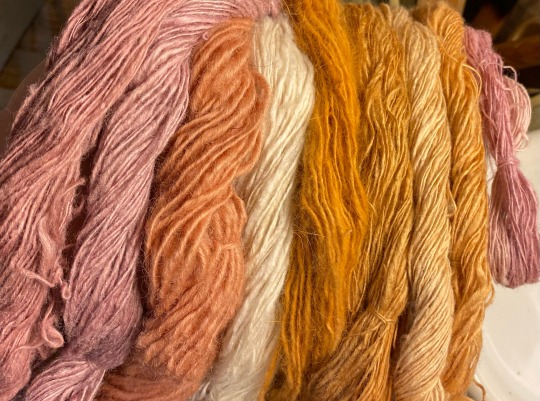

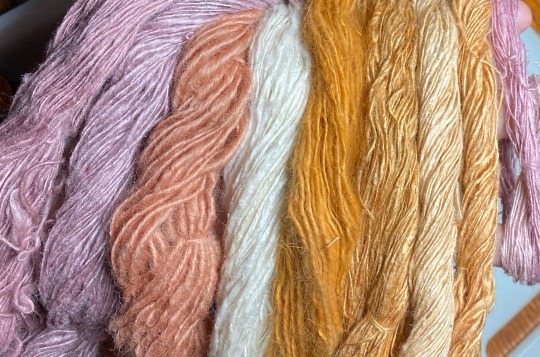
I took them under 3 different indoor light sources to try to show the variance of the colors, sadly not the sun as it is hiding behind the clouds as of late
from left to right: first two lavender-like purple are silk, dyed with an fuzzily-ID'd lecanora/ochrolechia like lichen that was AM prepared; the second one used the same lichens but prepared different (second ammonia soak)
the third one is wool using a similar lichen that was also AM prepared, i was almost worried it wouldnt work/i messed up the vat because i set the pH too low but surprisingly it didn't brown out and turned a lovely pink salmon color
the white is the base color of the silk
the fifth one is some french angora rabbit that i dyed using ruffle lichens via the BWM method; a lovely intense orange
the 6th and 8th were dyed with ruffle lichens (BWM) as well a long time ago so i don't recall the details
the 7th was dyed with usnea lichens (BWM) around the same time as 6 and 8
Finally, the last two tiny strings were AM dyed a long time ago and i almost forgot about making them!
Of course, all lichens should be collected from deadfall, not directly from a tree/rock/etc to avoid overharvesting. It's also important to keep chemical safety in mind if you work with ammonia, or even things like alum and vinegar!
All the yarn was spun myself on a drop spindle too, after dyeing the fiber clouds (very technical term i know)
I have more posts i want to make on lichen dyes and the making/using thereof once i get my head screwed back on correctly, specifically some recent shenanigans concerning the first three yarns! the chemical pigment itself, the history, the troubleshooting, etc. Which i think will be very cool
Bonus drop spindle, and a ruffle lichen comparison!

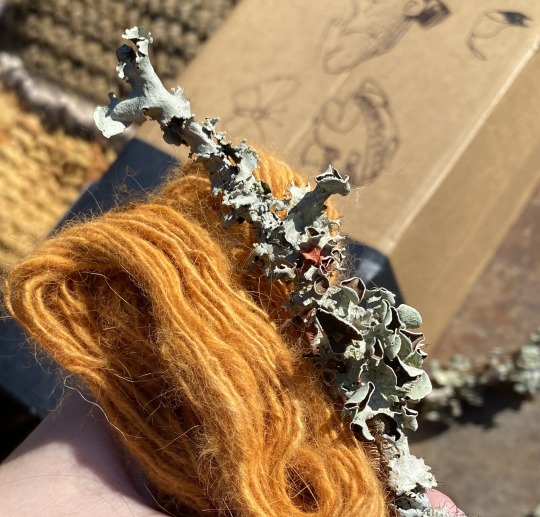
You can even see an orange spot on the otherwise minty slate green of the ruffle lichens where it had started to decompose!
#fiber arts#yarn#eri silk#wool#angora fiber#handspinning#natural dyeing#art#earth skills#crafts#ammonia fermentaion#lichen dyes#drop spindle
454 notes
·
View notes